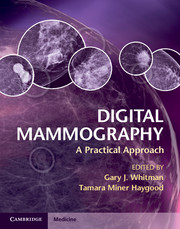Book contents
- Frontmatter
- Contents
- List of contributors
- Preface
- Acknowledgments
- Chapter 1 Detectors for digital mammography
- Chapter 2 Image acquisition
- Chapter 3 Preparing digital mammography images for interpretation
- Chapter 4 Image display and visualization in digital mammography
- Chapter 5 PACS, storage, and archiving
- Chapter 6 Interpretation of digital screening mammography
- Chapter 7 Efficacy of digital screening mammography
- Chapter 8 Artifacts in digital mammography
- Chapter 9 Mobile digital mammography
- Chapter 10 Procedures with digital mammography
- Chapter 11 Digital breast tomosynthesis
- Chapter 12 Breast computed tomography
- Chapter 13 Cases
- Chapter 14 Comparison of commercially available systems
- Index
- References
Chapter 12 - Breast computed tomography
Published online by Cambridge University Press: 05 December 2012
- Frontmatter
- Contents
- List of contributors
- Preface
- Acknowledgments
- Chapter 1 Detectors for digital mammography
- Chapter 2 Image acquisition
- Chapter 3 Preparing digital mammography images for interpretation
- Chapter 4 Image display and visualization in digital mammography
- Chapter 5 PACS, storage, and archiving
- Chapter 6 Interpretation of digital screening mammography
- Chapter 7 Efficacy of digital screening mammography
- Chapter 8 Artifacts in digital mammography
- Chapter 9 Mobile digital mammography
- Chapter 10 Procedures with digital mammography
- Chapter 11 Digital breast tomosynthesis
- Chapter 12 Breast computed tomography
- Chapter 13 Cases
- Chapter 14 Comparison of commercially available systems
- Index
- References
Summary
Background
The idea of breast computed tomography (breast CT) was conceived and explored not long after computed tomography (CT) was developed and commercialized. First attempts to image breasts with CT involved the use of a specially designed CT system (CT/M) [1–5] as well as a conventional body scanner [6,7]. The CT/M system suffered from poor image quality and long scanning times and did not prove to be practical. The use of a body scanner for breast imaging requires the entire chest to be exposed and included in image reconstruction. This causes two problems: first, the chest is unnecessarily exposed, increasing radiation dose to the patient; second, since the breasts are only a small part of the chest, only a small number of voxels can be used to represent the breasts, leading to poor resolution. These problems led to attempts to develop edicated CT units in which one of the breasts was scanned with dedicated scanning hardware, sparing the rest of the chest from radiation and allowing all available voxels to be used to represent the breast in the reconstructed images, leading to much improved resolution. This new imaging technique involved a different imaging geometry, often referred to as pendant geometry, with the patient positioned prone with one breast protruding downward through an opening and scanned by a specially designed scanner underneath the table. Because of technological limitations, this concept was not pursued until the early 2000s.
- Type
- Chapter
- Information
- Digital MammographyA Practical Approach, pp. 125 - 143Publisher: Cambridge University PressPrint publication year: 2012



